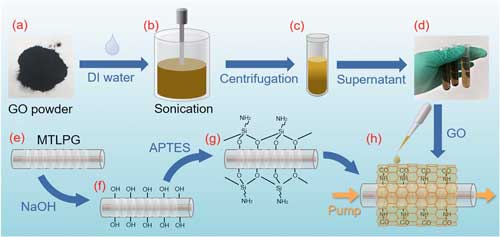| Jul 20, 2020 | |
A novel method for heavy metal sensing with graphene oxide(Nanowerk News) With the development of technology and the progress of urbanization, heavy metal pollution has become a huge problem facing society today. At the same time, heavy metal detection has become one of the most concerning issues of the public. |
|
| How to solve this problem? A research team led by Prof. Dr. KONG Depeng from the Xi'an Institute of Optics and Precision Mechanics (XIOPM) of the Chinese Academy of Sciences (CAS) has given us a reliable answer. | |
| They proposed a Ni2+ heavy metal sensor based on graphene oxide (GO) functionalized micro-tapered long-period fiber grating (MTLPG) where light-matter interaction is enhanced. | |
| The results were published in Applied Physics Express ("Graphene oxide functionalized micro-tapered long-period fiber grating for sensitive heavy metal sensing"). | |
 |
|
| Schematic representation of GO nanosheet deposition process. (Image: XIOPM) (click on image to enlarge) | |
How did they do it? |
|
| In fact, the long-period fiber gratings (LPFGs) and two-dimensional (2D) materials have shown extensive applications in optical sensing, optical communications, light processing, chemical, and biochemical sensors. | |
| Besides, GO as a very important derivate of graphene, it has similar properties to graphene. But the significant difference between GO and graphene is that hydrophilic oxygen functional groups such as epoxy, hydroxyl, and carboxyl are distributed on the basal planes and edges of GO. These oxygen-containing groups enable GO to be water-soluble and hydrophilic. | |
| In this work, they deposited a GO supernate on the cylindrical surface of the MTLPG, which fabricated by a CO2 laser heating source, by a chemical bonding method associated with physical adsorption and assisted by the optical tweezer effect. | |
| In terms of results, GO-fiber optic architecture features high sensitivity, real-time monitoring, stability, and reusability, and it provides a remarkable analytical platform for chemical and biochemical applications. |
| Source: Chinese Academy of Sciences | |
|
Subscribe to a free copy of one of our daily Nanowerk Newsletter Email Digests with a compilation of all of the day's news. |
